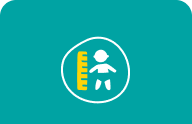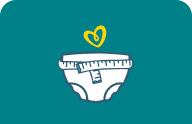Baby Swimming: Benefits of Lessons and When to Get Started
Playing in the water, whether it's learning to swim or just splashing around, is lots of fun for babies and young kids. And knowing how to swim is an important skill that can help keep your child safe all through life. That's why getting started with swimming lessons once your child is old enough is a smart move. Even if your baby isn’t ready just yet, you might consider doing some water play to get them ready for swimming lessons down the road.
Find out when you can take your baby swimming and the signs of readiness to look for.
It's also good to be aware of water safety, which is super important at every age and stage. Read on for some essential water safety advice that you should follow whenever your baby, toddler, or preschooler is in or near water.
When Can You Take Your Baby Swimming?
Have you been wondering when can babies start swimming? Experts recommend that you can start taking your little one to parent-child swimming classes as early as age 1. Because every child is different, though, you may find your little one isn’t ready to start swimming lessons until a little later.
It’s important to know that newborns and infants younger than 12 months old aren’t yet able to raise their heads above the water to breathe, so swimming lessons aren’t appropriate for them just yet. So, when can babies swim? Starting at age 1, your baby may be ready for parent-child swimming classes.
In your baby’s first year, you might like to do parent-child water play classes with your baby to help them get used to being in water. This can
get your baby accustomed to being in a pool
be an opportunity for bonding as you play together in the water
help your baby get over any fears they may have of being in the water.
Some parents wonder when babies can go in a chlorine pool. Chlorinated pools are generally safe for babies over 6 months, but always check with your pediatrician first.
When deciding when to start your child on swimming lessons, take into account your child's
emotional maturity
physical and developmental abilities or limitations
interest in learning to swim
comfort level in water.
Your child's physical readiness is important. For example, crawling is a significant milestone that indicates motor skill development. Read more about when babies crawl to understand your child's development.
Most children are ready for regular swimming lessons by the age of 4 when they can grasp basic skills such as
floating
treading water
finding a way out of the water.
While experts recommend starting at age 1, the best age to start swimming for babies depends on your child's individual development. If you’re ever unsure when to start your child on swimming lessons, ask your child’s healthcare provider for personalized advice.
Benefits of Swimming Lessons
Knowing how to swim is super important, as it can help prevent drowning. Studies have shown that swimming lessons can help reduce the drowning risk for toddlers and young children between the ages of 1 and 4, so you might want to take this into account when deciding when to start your little one on lessons.
Still, know that swimming lessons don’t make your child “drown proof.” You will need to carefully supervise your child whenever they are in or near water. And, if you have a pool at home, it's crucial to block access when you’re not there to supervise. You can learn more about this in our section on water safety [anchor link to How Do You Ensure Water Safety for Your Child?].
On the bright side, swimming and water play can be fun activities for your child. Like many sports, swimming can help build confidence and it can be a steppingstone for developing other life skills.
What Kind of Swimming Lessons Should You Enroll Your Child In?
Toddlers and young children may benefit from classes that focus on swim readiness skills. Parents are often included in these classes and can pick up pointers on how to safely supervise their child.
By the time children turn 4 years old, they are usually ready for standard swimming lessons. These would include learning stroke techniques as well as water survival skills such as
getting back to the water’s surface from under water
propelling a minimum of 25 yards
getting out of the water.
When choosing a swimming instructor for your child, check that the instructor
is qualified and certified to teach swimming
will give you the chance to observe a lesson in action before you make a decision
offers an atmosphere that is appropriate to your child’s age and development
encourages safe habits such as never swimming alone or without permission from an adult
can teach your child what to do if they fall into water by accident
allows you to be near or alongside your child in the water
requires your child to take multiple lessons so that there is noticeable progress
evaluates how your child is progressing and gives you feedback after lessons.
Besides all of this, you should check out the swimming facility firsthand. Ensure that the water is clean, disinfected, and chlorinated. Ideally, the water would be heated to between 87 and 94 degrees Fahrenheit. Water temperature is especially important for children under the age of 3, who are at a higher risk of hypothermia.
How Do You Ensure Water Safety for Your Child?
Providing constant, focused supervision is the most important thing you can do for your baby or young child who is learning to swim or is in or near water.
Childhood drowning is more common than you might think, and young children can drown in just an inch or two of water. It pays to be extra vigilant when your child is around water.
Here are some important steps to take to help keep your child safe when they are swimming or are anywhere near water:
Always give your child your undivided attention. Don’t think that because there’s an on-duty lifeguard by the pool or at the beach that you can read a book or use your smartphone.
Don’t drink alcohol or use drugs when supervising your child.
If your child is learning swimming at a younger age, it will be important for you to do “touch supervision,” which entails you being close by or joining them in the pool.
Don’t leave your child in the water under the supervision of another child.
If you’re hosting or attending a pool party, assign the job of a “water watcher” to someone who can keep a constant eye on the children in the pool. Rotate the job in shifts so someone else can take over the responsibility after a short time. Make sure that the water watcher knows CPR and knows how to swim.
Keep an extra close watch on toddlers and young children between the ages of 1 and 4 as they are at the highest risk of drowning. If your child is in this age range, they’re naturally very curious and can easily sneak away from you even when it’s not swimming time. This is why it’s important to secure your home swimming pool if you have one.
If you’re at the beach, a lake, or a river, make sure your child wears a life jacket that fits properly and has been approved by the U. S. Coast Guard. If your child isn’t a strong swimmer, they may also need to wear a life jacket at the pool or water park.
Be prepared to respond if your little one’s in trouble in the water. It’s a good idea for you to learn CPR and rescue techniques. Classes are available through the American Red Cross and the American Heart Association. Your local fire department and other community organizations may also offer first-aid classes.
Keep in mind that whenever your child is swimming outdoors you should also make sure that their skin is protected from the harmful effects of the sun with sunscreen.
Home Swimming Pool Safety
If you have a swimming pool at home, you'll need to follow certain rules while it’s in use and keep it secured when it’s not being used.
When your swimming pool is in use, follow these guidelines:
Don’t let children run around the pool or push one another into the pool.
Don’t let your child use an inflatable mattress or floating toy, as they may slip off it into deep water or it may deflate unexpectedly, endangering your child’s safety.
Make sure that the deep and shallow ends of your pool are marked, and never let your child dive into the shallow end.
Remove the pool cover completely before letting anyone swim.
Don’t let your child walk on the pool cover while it’s covering the pool, as they could accidentally fall in and get trapped underneath.
Make sure your pool’s drain covers are properly maintained, as suction from drains can trap swimmers. You may even consider installing anti-entrapment drain covers.
It’s a good idea to have a safety ring connected to a rope or a shepherd’s hook near your swimming pool.
Here’s how to keep your swimming pool secured when not in use:
Surround your pool (including above-ground and inflatable pools) with a fence on all sides.
The fence should be a minimum of four feet high and have no opening in the slats wider than four inches.
The gate of the fence should be self-closing and self-latching. The latch should be at least 54 inches above the ground, and the gate should open away from the pool.
Make sure that the gate is always securely locked.
It’s a good idea to keep your pool covered, but a pool cover should never replace the use of a fence.
Check your local laws to find out whether there are any additional safety requirements for your home swimming pool.
Don’t leave toys in or around the pool, as these are enticing to children even when it’s not swimming time.
If you have a spa, hot tub, or whirlpool, keep it covered and locked when not in use. Keep in mind that children under the age of 5 should not be allowed to use these to help reduce the risk of drowning or overheating. Also, remember: Never leave your baby or child unattended in the bathtub—not even for a moment.
If you've been wondering when you can take your baby swimming, enrolling your little one in swimming lessons once they’re old enough can give your child lifelong skills and confidence in the water. Even in your baby’s first year, you can consider water play classes to familiarize your baby with water and to set the stage for learning to swim. The best age to start swimming lessons for babies is around 1 year of age or when they feel comfortable in water. Starting early can be beneficial.
Whether your little one is playing on a beach, splashing in a tub, or paddling in a pool, remember to always practice good water safety habits. These moments are perfect for introducing them to water. Enjoy this time together!
How we wrote this article The information in this article is based on the expert advice found in trusted medical and government sources, such as the American Academy of Pediatrics and the American College of Obstetricians and Gynecologists. You can find a full list of sources used for this article below. The content on this page should not replace professional medical advice. Always consult medical professionals for full diagnosis and treatment.
Join a World of Support
through Pregnancy and Parenthood.
TRACK WITH TOOLS
LEARN WITH EXPERTS
GET REWARDED












